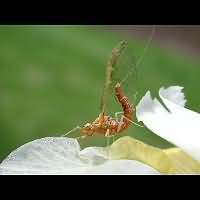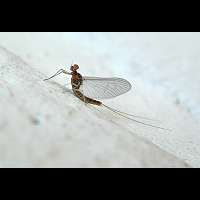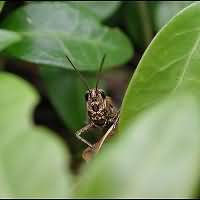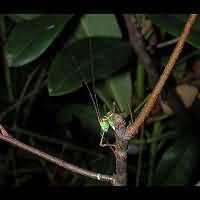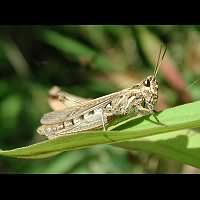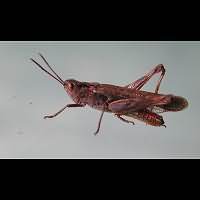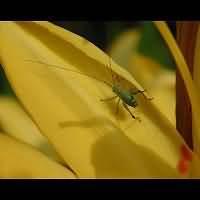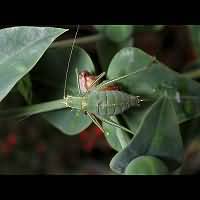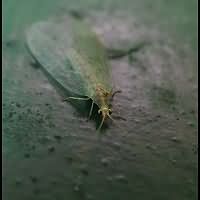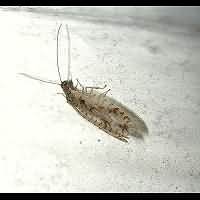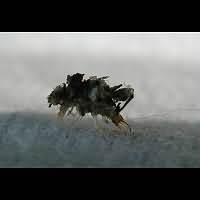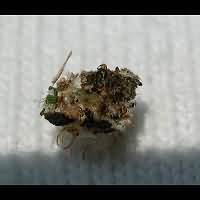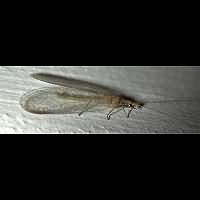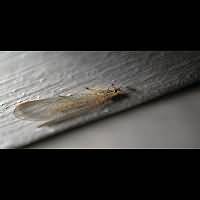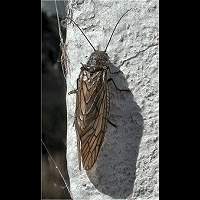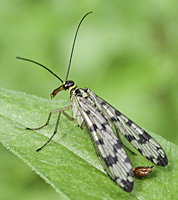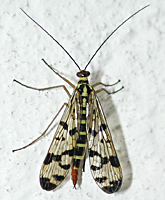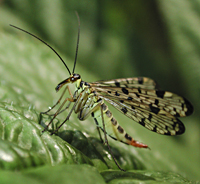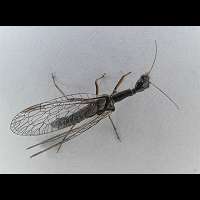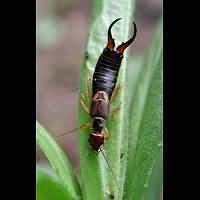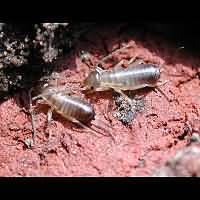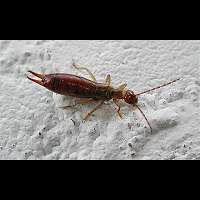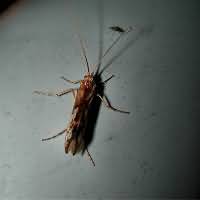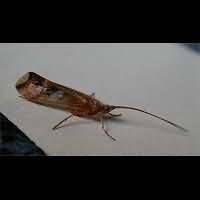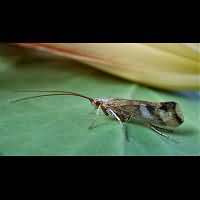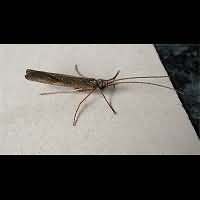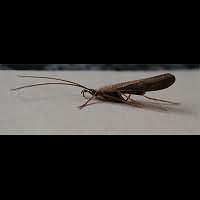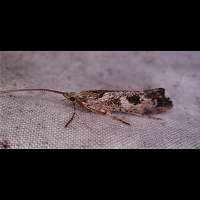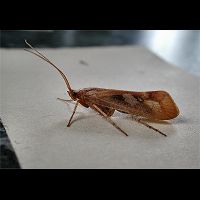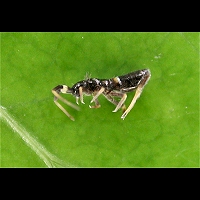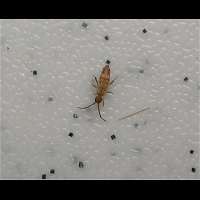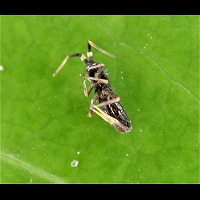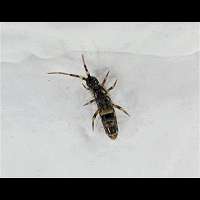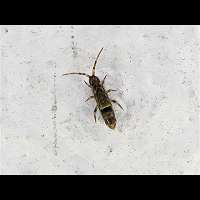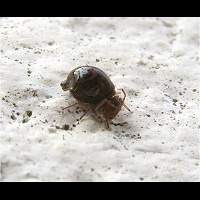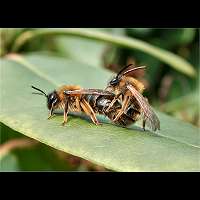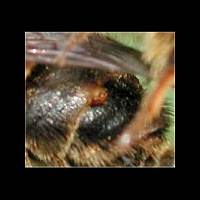[All pictures of garden wildlife on this page are thumbnails. Click on any thumbnail for a large format to be displayed. I normally use the animal's English name (if it has one). However the scientific name of the species is always mentioned in the photograph's captions. For some species an additional page containing more pictures is available.]
Crickets, May-flies and Other Insects
Contents: 1 May-flies, 2 Grasshoppers, 3 Net-winged Insects, 4 Scorpion-flies, 5 Snakeflies, 6 Earwigs, 7 Caddis Flies, 8 Springtails, 9 Booklice and Barklice and 10 Twisted Wing Parasites.
![]()
Mayflies in Dutch are called "One Day Flies". The adults live for a short period of time only: they mate, the female deposits her eggs in the water and they die. Adults do not even eat or drink during their short life. May-flies are very primitive insects that have been flying around for millions and millions of years. Attached to the backside of their bodies are always two or three very long hairs or wires. The larvae, called nymphs, live in water. All species look alike and it is almost impossible to distinguish between them when you're not an expert. So I did consult experts to help me with identifying the species below and this is what they answered: 'the species on the fotos is Cloeon dipterum (L.), a female, very common throughout Europe and very typical for smaller standing waters, as garden ponds. Biology is interesting as being ovoviviparous (as some nearctic Callibaetis). Females come into the houses for several days, to leave it after moulting, leaving their subimaginal skin at the house walls.' Now I must admit I had to look up the word ovoviviparous. I remembered the word from my schooldays, but I didn't remember the exact meaning of this difficult word. It means that normal insect eggs are produced, but not deposited. The eggs are kept inside the body, also during hatching. The young then leave the body of the mother alive. There are not many animals that do the trick. Some spiders and sharks give birth that way. Mr. Haybach then continues his identification with a subject for a typical scientifc dispute. 'There is a little problem, not with the taxonomy, but with the systematicsof this species. Some european workers as Eva Engblom, R. Sowa and me think that there are three species within a closely related group. (C. dipterum, C.cognatum, C. inscriptum) while the majority of european workers regard those as synonyms to C. dipterum."
We had quite some pictures of may flies on our site, wondering whatever species they could represent. Craig Macadam provided us with the answer: all belong to the same Cloeon dipterum group and all are very likely to be Cloeon cognatum!
Probably Cloeon cognatum, a May-Fly species with two wires. The female is to the left, the male is to the right.
2 Grasshoppers and locusts (Orthoptera)
Grasshoppers and locusts are members of the well known group of insects that chirp, jump about and sometimes are a pest, especially if they arrive in very great numbers. Ordinary grasshoppers and locusts are vegetarians. They all have rather short and robust horns. The so-called longhorned grasshoppers eat both plants and other insects. They have very long and thin horns and the females have an impressive sword, used to deposit the eggs.
To the left: head of a common Grasshopper and to the right: head of a Longhorn Grasshopper.
There are many species of ordinary grasshoppers in Western Europe and it is very hard to identify the exact species as many of them look very much alike. It is also hard to tell the nymphs apart from the adults. All these grasshoppers are active during the hours of daylight. The species below could be the Common Field Grasshopper. It belongs to the Chorthippus group. However in the Low Countries you will found some 8 species within the group. Many really resemble one another very much and what is more they are all variable in colour within each species: brown or green or a combination of both colours. Real experts can tell the species apart by listening to the song they 'sing'. That's how we now know for sure that we do have the Common Field Grasshopper in our own garden: it produces very short 'zzz'-sounds (of less than one second). This tone is then monotonously repeated every 2 to 4 seconds. In Dutch the various Chorthippus species have beautiful names such as the rattler, the screecher and the locomotive.
The adult of the Common Field Grasshopper (Chorthippus brunneus) is to your left, the nymph to the right.
In our garden the Bow-winged Grasshopper is a frequent visitor as well. It's the spitting image of the Common Field Grasshopper, except for the somewhat broader wings. The sound it produces is very different from that of the Common Field Grasshopper. First of all the sound is much louder, sounds more metallic and each chirp lasts at least 2 to almost 3 seconds. The chirps end abruptly and usually there are three of them in a row. Like most other species the Bow-winged Grasshopper loves sandy or rocky conditions and warmth. In dry, hot summers there are not only more of them, but they also produce more noise than in cold or wet summers.
The Bow-winged Grasshopper (Chorthippus biguttulus) produces much more noise than the Common Field Grasshopper does.
Some grasshoppers, like the Long-horned Grasshopper, Speckled Bush-cricket or Katydid develop a long sabre-kind of growth on the back-side. Only the females have this sabre and it is used to deposit the eggs. The larvae of the Bush Cricket look a lot like the females: green, with long horns and lots of dots, but they lack the sword of the females, the brown striping on the back of the males and the (rudimentary) wings. Depending on their age, they are also (a lot) smaller.The adult female is completely green with lots of dots. There is a slight dark line on the back and of course she has the sabre. The adult males have a thick dark line on the back and their legs are partially brown, but they lack the sabre.
From left to right the nymph, female and male of the Speckled Bush-cricket (Leptophyes punctatissima).
3 Net-winged Insects (Neuroptera)
Ant-lions, Lacewings and Alderflies are related to eachother. You can tell so by looking at their heads and the large wings. The larvae of almost all species are hunters. The order is named after the numerous veins in the wings, which make out an intricating pattern. The Snake Flies used to be part of this order too, but are now considered to be an order by themselves. And even though we do deal with the Alder Flies here, they are often considered to be an order of their own as well. That order is called the Megaloptera and is comprised of Alder Flies and the Northern American Dobson Flies and Fishflies.
Contents: 3.1 Ant Lions, 3.2 Lace Wings, 3.3 Alder Flies
The adults of the ant-lion resemble a small damsel-fly a bit. But if they fly you see the difference instantly. They can be considered really poor flyers. Ant-lions are very interesting insects. They got their name from the behaviour of the larvae, rather than that of the adult. The larvae make a little, round ditch, preferably in loose sand. In the bottom of the ditch the animal digs a small passage-way. It hides itself in the passage-way and then waits for what is about to happen. Ants are very curious insects, so the ditch will certainly attract their attention. However investigating this ditch proofs fatal for a curious ant. The sand is too loose, the ant slids down and can't get out of the ditch any more. The ant-lion crawls out of the passage-way and eats the ant.
The Ant-lion in the picture lived for a short time only. After I made a very few shots of the animal sitting on clothes-line it decided it had enough of posing and flew away laboriously. It flew towards a nearby oak, so I followed it with my eyes to see where it would land. Suddenly a Black Cap - a small warbler that inhabits our garden every summer - appeared and ate my model. That is why I have only the following picture of the ant-lion and I'm sorry it is not a very exciting one. The species in the picture below is very rare in Britain and is only found in the Minsmere and Suffolk (along the coast) and probably in Norfolk.
This Ant-lion (Euroleon nostras) is very rare in Britain indeed.
The larvae of Lacewings eat all kinds of harmful insects that damage plants, such as plant lice and leaf lice. They are cultivated and set free in green houses to consume the leaf lice on cucumbers and tomatoes, in order to use less chemicals. Green Lacewings are very well known, but there are also brown ones.
To the left a Green Lacewing (Chrysoperla sp.) and in the middle a Brown Lacewing (Micromus variegatus?) and its larva to the right.
The larvae of some of the Green Lacewings are very special, for the camouflage themselves. They have long and stiff hairs all over their body and on these they put the skins of their sucked dry victims. After some time they are all couvered and go about unnoticed. They don't do this in order to get their prey (leaf lice hardly move about at all), but to deceive the protectors of the leaf lice: the ants.
The camouflaged larva of a Green Lacewing (Dichochrysa sp.). At the front the formidable jaws.
In Western Europe the best known lacewing is the Common Green Lacewing. Born green, the colour changes to brown in autumn. The animal hibernates in this brown adult state and mates in spring. The larvae eat plant lice, the adults eat neactar from flowers as well. The Common Green Lacewing is a creature of the night. By day it only flies away when disturbed. Just like ant-lions lacewings are not very apt flyers. The larvae of the Common Green Lacewing do not camouflage themselves at all. In Western Europe there are about five species of green lacewings. These are all almost identical and onlty experts can tell them apart by just looking at them. They are easy to tell apart though. Each species hibernates in another stage: some being an egg, others as larva and the Common Green being adult. In biological farming the Common Green Lacewing is one of the most popular enemies of plant lice.
Three pictures of a hibernating Common Green Lacewing (Chrysoperla carnea), which is brown, of course...
Nowadays the Alder Flies are often considered being a complete order on their own. It is called Megaloptera, which means Megawinged. It thus is one of the smallest insectorders in Europe, represented by some 2 to 6 species in most Western European countries. All our Alder Flies are brown with big wings and clearly marked black veins. And like in the other Neuroptera these make out an intricate pattern. Of the British species only one is well known: the (Common) Alder Fly.
The Alder Fly is a darkbrown flying insect. It has a rather robust body and big wings, which are folded over the body like a roof top when the animal is at rest. The wings do contain a lot of veins. These veins are very striking indeed, for they are very well marked and black in colour. When resting the animal is very similar to the Caddis Fly. It has bare wings, though. The antennae are long and build up of numerous segments. The animal is a very bad flyer. When it flies, the flight is always slow and short. The animal rather crawls or climbs. The adult Alder Fly measures around 20mm in length. Depending on the temperatures in winter and spring, the adults appear in April or May, often appearing in great numbers at about the same time. The adults are seen in rapidly declining numbers to the end of June. Males are short lived and usually die within a day or two after leaving their pupa. Females live a bit longer and maybe around for three to four days. Even though they sometimes take some water or other fluids, adult Alder Flies do not eat. Females lay their eggs on the stems of plants above water. She lays them in tightly connected rows. On the plants the greyish brown eggs are visible as rectangular bundles. Depending on temperature the eggs will hatch within three weeks, usually all at the same time. The larvae fall into the water, or crawl to the water if they fall on land. The larvae prefer muddy, soft grounds and love living among detritus. They are real carnivores, even eating their own kind, given the chance. Their main enemies are the larvae of damsel flies and dragon flies. The larvae remain in the water for 2 years. During this period they moult no less than 10 times! When it is time to pupate the larvae comes out of the water and digs a small hole in the ground. It may also pupate between plant roots or leaf litter. The pupa is not made within a cocoon. Pupation may be extremely fast: after 4 days only the new adult enters life. Usually pupation takes longer, but rarily over 4 weeks. The Alder Fly is common over much of Britain and continental Europe. In some years it appears in enormous numbers in spring time. The animal spends most of its life under water, but it does not have many demands. Any standing or slowly floating water will do: a river or canal, a swamp, a lake or a small garden pond.
The Alder Fly (Sialis lutaria) often appears in spring time in huge numbers.
Another small group of insects is called scorpionflies. They owe their name to their strange, often coloured tip on the back of the body, resembling the famous scorpion's tail. The males have a much bigger tail than the females. There's no need to be afraid of them: in spite of the dangerous appearance scorpionflies can neither sting nor bite. They feed on rotting fruit and plants mainly.
Left: Panorpa vulgaris (male), middle: Panorpa communis (female), right: Panorpa germanica (female)
Only few people have ever heard about Snakeflies and even fewer have actually ever seen them. They are not very rare, though. Their small size, unobtrusive behavior, hidden larval stage and short adult stage puts them among the more obscure insects. The adults have a very long neck, which is used to keep the head above the body. The larvae live among roots of plants and trees or under bark and hunt for other insects or their larvae. It often takes them 2 or 3 years to complete their development. Pupation doesn't take very long and the pupa is among the most active of all insect pupae: it is still capable of walking! The adults appear in spring mainly and hunt for plant lice and other small insects. The species in the pictures below is found frequently near conifers of all kinds.
One of the most common Snakeflies: Raphidia maculicollis. It is on the wing in April, May and June.
Earwigs belong to a group of insects of their own. And where most major insectgroups have very varying species, earwigs are all pretty much the same. Even experts have difficult identifying a species, but the dangerously looking equipment at the end of the body varies per species, thus enabling identification. Many earwigs can not fly. Even the Common Earwig, which can fly rather well, hardly ever does. Earwigs eat rotting plants, although some species are carrion. Mother earwigs in many cases not only protect the eggs, but the young as well. Oh, and don't worry: as far as we can remember nobody actually had this animal wiggling in his ear!
This is by far the most common earwig in Europe, called... the Earwig (Forficula auricularia). On the right the nymphs.
The Woodland Earwig is slightly smaller than the common earwig is. It is also less contrastring and comes in one kind of brown only. The pincers of both sexes do not have the little tooth on the inside the common earwig has. You can see some small things you could call wings. Actually these are rudimentary front wings. There are no hind wings at all and the Woodland Earwig is therefore unable to fly. You can find him in woodlands especially, where it is running through leaf litter looking for food. It may however climb into trees and shrubs as well. The Woodland Earwig is active all year around. Only during periods if frost it will hide behind some loose bark, waiting for more favourable circumstances. Even though we are not absolutely sure, we think this is not a British species.
The Woodland Earwig (Chelidurella acanthopygia) can't fly. Probably that's why it is not a British species.
Worldwide over 6000 species have been described. In Holland some 177 species of caddisfly exist. In Britain some 190 and in Belgium well over 200 species have been found. Best known are the larvae which live in water and build cases around them. The produce a kind of silk to which they stick whatever they find in the water. These cases differ with each species, even though closely related species make more or less the same case. The cases sometimes are apparently randomly made of whatever the animal was able to find, rather like some of the cases used by the bagworm moths, or the way the larvae of Green Lacewings camouflage themselves. Others are meticulously constructed of twigs, pebbles or shells of the same size and colour. Other species build a case on a flat stone. The silk is sometimes also used to build a net to catch prey. While some species are carnvivores, most will eat almost anything. The adults are all brown, dull looking animals. The wings are big and hairy and folded like a roof over the body. They are not among the best of flyers, yet often found far from water. They are easily attracted by light. Some of them will eat some nectar, but most imagines don't eat at all. The antennae are often very long, thin and wire like.
Two Caddis Flies (Trichoptera), Leptoceridae sp. (quite probably belonging to genus Oecetis), Limnephilus sp.
The adults do look like lace wings and may flies, but they are not related to those groups. Actually they are close relatives of moths. Caddisflies and Moths have been sharing common ancestors in times long gone by. Caddis flies however do not have the typical moth tongue and their wings are covered with hairs instead of scales. Close ups reveal their beauty.
A close up reveals the beauty of this Caddis Fly, Limnephilus lunatus.
Most species are just brown and very difficult to put a name on. Besides, good (field)guides are lacking. In most general fieldguides beautiful pictures of the larvae and their constructions are presented, but there is baffling little on the adult flies. Below one of the brown species Molanna angustata. There are no markings, apart from a slightly lighter smear near the loweredge of the wing.
Modest looking brown Caddis Fly is Molanna angustata.
Finally two species with a name. The one to the left was identified by Juha Salokannel (from Finland) as Glyphotaelius pellucidus. Knowing the animal's identity is nice, but it doesn't bring a lot, for neither in our books, nor on the internet you'll find a lot about it. The mere known piece of information is that this species is fond of more acid water. It was quite common in the 1970's en 1980's, but the numbers are declining now which is presumably due to the fact that the fight against acid rain is going on successfully. Below to the right the Limnephilus rhombicus. It is a well known species, especially among anglers. The larva doesn't use sand or other hard materials for building its case, it uses plant materials only. One of the few caddis flies which may be a pest. The numbers of larvae in Watercress Beds may become enormous!
Glyphotaelius pellucidus to the left and the Limnephilus rhombicus to the right.
Springtails are very small and primitive insects. They even belong to a subclass of the insects, along with among others the Silverfish and Coneheads: the Apterygota (=wingless). Within this group not even the adults ever have wings. And even though they do change skin from time to time they do not change the way they look. The larvae are just smaller images of the adults. These animals all have wires on the tail (the so-called cerci). Usually they have two, but silverfish for instance have three. They are hard to see in Springtails, for they have the wires folded under their bodies. They are used to jump with, hence the name of the group. In the picture below this jumping device is clearly visible.
This springtail clearly shows its jumping device, after which it and all its relatives are named.
Springtails are never big. The giants may reach some 10 mm, many even remain below the size of 1 mm. Another characteristics of these wingless insects is the fact that they have single eyes and very few body segments. They feed on rotting organic materials and fungi. They are present in great numbers, but because of their size are hardly ever noticed. Below most probably Entomobrya nivalis, a moss dwelling creature.
A well marked springtail, mainly found in mosses: Entomobrya nivalis.
By the way: DNA studies of these animals has lead to a new theory: they are actually not primitive insects, but primitive lobsters. That would explain the continuous shedding, even once adult, and the forked tail, not found in any other insects. For the time being we will leave them here with the insects, where they have been dealt with for centuries now. That might change within the next few years, though. The species below is one of the easiest to identify. Still I needed George Tordoff to make the identification, for there are no good books, nor good sites about these little creatures, alas. Below one of the easiest species to identify. In close up it even proofs to be quite well looking. It is a very common species all over Europe and is probably present in every garden, without ever being noticed.
A very attractive springtail to be found in everyone's garden is this Orchesella cincta.
Below two pictures of a young of the same species. Within the order of Springtails Orchesella is a remarkable genus, for their antenna exist of six members (parts). Usually Springtails have antennae existing of 4 parts only, but strangely Orchesella has 6. Now in its jumpy life something may happen to a Springtail causing part of the antennae to get lost. Not a big problem, for after the next peeling the antenna is likely to be restored. But this doesn't always happen in the right way. The animal in the pictures below apparently lost the first (or last) two parts of its right antenna. After the last peeling they were replaced by just one, very long segment. Just compare the left antenna to the right one. In Orchesella species this happens very frequently. In the 19th century scientists even thought this was characterisic of this genus.
A young Orchesella cincta having one of its antennae deformed. This is often the case in Orchesella species.
Without an extensive study under the microscope most springtails are extremely hard to identify. Of the animal in the picture below we only know that it is almost certain it belongs to a family called Sminthuridae. This family is comprised of many, often very similar species. Most are circular shaped, shiny animals, usually dark on top. Some species are very common in gardens and near houses. Yet they are seldom seen, due to their small size.
Springtails belonging to the family Sminthuridae are all very similar and hard to identify.
9 Booklice and Barklice (Psocoptera)
Springtails may be small, booklice and barklice are smaller still. Booklice for instance are present in most homes, but no one ever sees them. Booklice and Barklice are all very small insects showing a flattened body, a broad head and long, usually wirelike antennae. Many species remain wingless. Those species growing wings often look like very small plant lice. The veins runs very differently, though. Besides plant lice have needle shaped jaws, those of Psocoptera are made for biting. In many species males are unknown or very rare. Reproduction often does not require the presence of males (parthenogenetic). Most species will eat pollen, the spores of funghi or algae. On wood we will often find bark lice. Some are striking, because of their size. Barklice may cause damage on wood. In the days all ships were made out of wood, they were very feared among sailors.
The Bark Louse below most likely is Metylophorus nebulosus. It is a giant among the Psocoptera, for it will reach a length of 4mm, where most species hardly reach 1mm. It lives on the bark of shrubs and trees. It is found on both deciduous and coniferous trees. And not only in forests, but on isolated trees as well. Is found in enormous quantities on Norway Spruce. Like most barklice Metylophorus nebulosus eats lychens, algae and fungus spores it finds on the bark. This species is single-brooded. Lives in Europe, the moderate zone of Asia and Japan.
Reaching some 4 mm this Metylophorus nebulosus, a Bark Louse, belongs to the giants among the Psocoptera.
10 Twisted-wing Parasites (Strepsiptera)
This is an order of insects nobody notices. Even scientifically little is known about these creatures. They are all small insects, fully adapted to living the life of a parasite inside another insect. After hatching the larvae have legs and are quite mobile. Immediately they search for a host. Once they find one they use an oral secretion to soften the chitine of the host and crawl inside. Once in the larva moults at once and turns into a maggot like creature without eyes or legs and with a very rudimentary mouth. It lives by filtering particals out of the blood of the host. Even oxygen is taken from the host's blood. Their skin is adapted for both these tasks, so the mouth is not used anymore. The females keep on looking like a maggot, even when adult. They develop no wings, antennae, eyes, legs or even external sexual organs. After having moulded for the last time, they just stick their heads out of the host's body between two segments. They are now waiting for a male to mate. The males however moult into real insect-looking creatures: they have a mouth, legs, antennae, strawberry like eyes and one pair of wings. The other pair is reduced to halter like organs, just as in flies. The difference is that in flies it is the second pair of wings that is reduced, in twisted-wing parasites it is the first pair. The males live for a couple of hours only and die right after mating. The females produce a great number of offspring, wich probably indicates most larvae won't find a host in time.
At this moment there are some 600 species known to man, of which only 17 live in Britain. Because they are extremely hard to find, it is possible there are many more species, probably even in Britain. In Europe most species are parasites to wasps and bees. A few species are known to attack bugs. Most species are so inconspicuous you'll never see them at all. Only one species, Stylops melittae, is sometimes seen, when the adult females stick their head out of the host, unvariably a bee. A bee infected with a parasite is called a stylopised bee. Such a bee sometimes behaves oddly and it is claimed he or she is infertile. The picture below proves that a stylopised bee is still capable of mating. You can see the head of the parasite sticking out between two segments of the female bee just in front of the males front leg. We are probably talking about Andrena tibialis, a mining bee. Mining bees are regularly found to be stylopised.
The female mining bee above (probably Andrena tibialis) has been stylopised by a parasite: Stylops melittae.


© Copyright 1998-2024 gardensafari.net (Hania Berdys)

 English / engels
English / engels  Dutch / nederlands
Dutch / nederlands